In 1961, President John F. Kennedy committed the United States to landing a man on the Moon and returning him safely to the Earth before the end of the decade. His announcement accelerated NASA’s long-term lunar mission plans using a new three-person spacecraft called Apollo.
In 1961, President John F. Kennedy committed the United States to landing a man on the Moon and returning him safely to the Earth before the end of the decade. His announcement accelerated NASA’s long-term lunar mission plans using a new three-person spacecraft called Apollo. The agency selected North American Aviation (NAA) in July 1961 as the prime contractor to design and build the Apollo spacecraft. NASA’s adoption of the lunar orbit rendezvous mission profile for the Moon landing a year later necessitated significant changes to the spacecraft. NASA and NAA signed the definitive contract for the Apollo Command and Service Modules on Aug. 14, 1963, at the time the largest single research and development contract in the U.S.
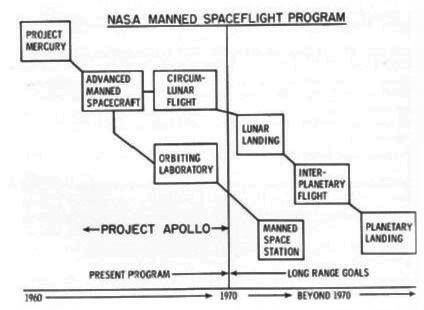
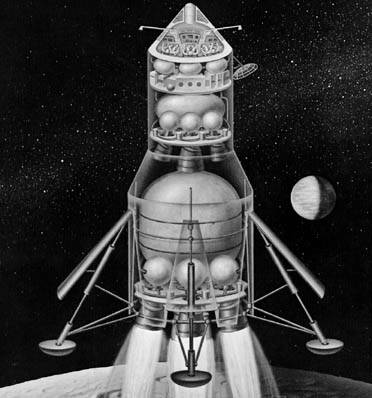
Left: NASA’s July 1960 plan for an Apollo program to follow Project Mercury. Right: Illustration from 1961 of a concept for an Apollo lunar landing vehicle using either an Earth orbit rendezvous or a direct ascent mission profile.
Early designs for an advanced spacecraft predated Kennedy’s announcement. In July 1960, publicly using the name Apollo for the first time, NASA Deputy Administrator Hugh L. Dryden announced the program to industry representatives invited to a series of Space Task Group meetings in Washington, D.C. During the meeting, George M. Low, NASA’s Chief of Manned Space Flight, presented a plan for Apollo, to follow the one-man Mercury flights, as a spacecraft capable of carrying three astronauts and designed for fights to an Earth orbiting laboratory and eventually flights to the Moon. President Kennedy’s commitment put a timetable on the project and provided a Moon landing as a goal for Apollo. On July 28, 1961, NASA sent out a Request for Proposals to 16 companies or teams that had expressed an interest in the project. Five responded by the Oct. 9 deadline. On Nov. 28, 1961, NASA selected the Space & Information Systems of North American Aviation (NAA), based in Downey, California, as the prime contractor to design and build the Apollo Command and Service Modules (CSM). NAA’s pertinent relevant aerospace experience and longtime support for National Advisory Committee for Aeronautics (NACA) and NASA projects, for example the X-15 rocket plane, formed the primary basis for the selection decision, along with NAA having the most attractive cost proposal.
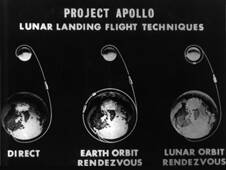
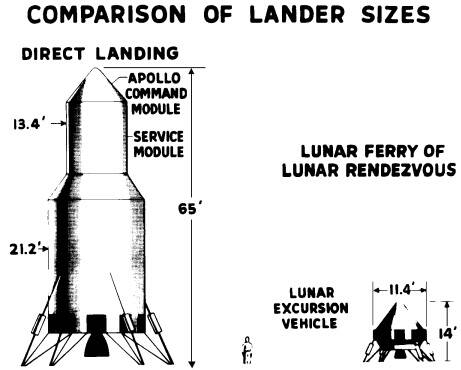
Left: A 1962 schematic diagram of the three options for carrying out a lunar landing mission. Right: Comparison of the size of the lunar landers required for the Direct Ascent, left, and the Lunar Orbit Rendezvous approaches.
Although the Apollo spacecraft underwent many changes large and small, the biggest it faced early in its development revolved around NASA’s July 1962 decision to use lunar orbit rendezvous (LOR) instead of its previously favored Earth orbit rendezvous or direct ascent as the mission profile for the Moon landing. Because those two earlier scenarios envisioned the CSM landing on the Moon, use of LOR required significant modification of the CSM and the separate development of a unique landing vehicle, first called the Lunar Excursion Module, later shortened to Lunar Module. The LOR scenario required the addition of a docking system and an internal crew transfer tunnel to the Command Module. To save time and minimize cost, managers decided to retain the Service Module’s powerful Service Propulsion System engine, needed for liftoff from the Moon’s surface in the direct ascent scenario but needed only for the lower thrust lunar orbit insertion and escape maneuvers in the LOR profile.
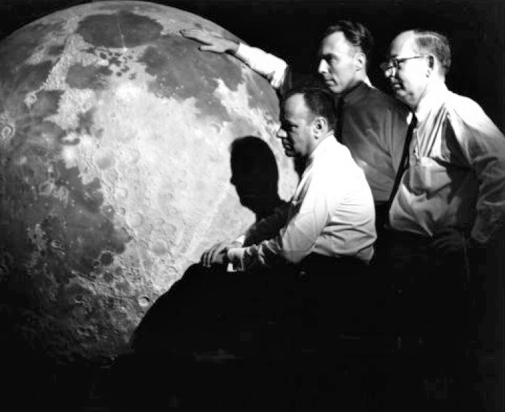
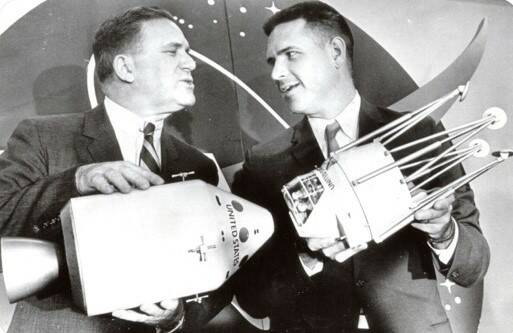

Left: Key Apollo personnel at North American Aviation Harrison A. Storms, president of North American Aviation’s Space and Information Systems Division, left, John W. Paup, Apollo program manager, and Charles H. Feltz, Apollo program engineer, study a Moon globe. Middle: NASA Administrator James E. Webb, left, and Office of Manned Space Flight Director of Systems Engineering Joseph F. Shea hold models of the Apollo Command and Service Modules and a proposed lunar landing vehicle during the July 1962 press conference announcing NASA’s decision to use lunar orbit rendezvous. Right: NASA astronauts M. Scott Carpenter, left, John H. Glenn, and Walter M. Schirra in an Apollo Command Module prototype in March 1963.
On Aug. 14, 1963, NASA Administrator James E. Webb signed the definitive cost-plus-fixed-fee contract for the Apollo CSM with NAA. The agreement, valued at $938.4 million, constituted the most valuable single research and development contract in the U.S. up to that time. It called for NAA to initially produce and deliver to NASA 11 spacecraft mockups, 15 boilerplate or engineering test vehicles, and 11 production spacecraft through May 1965. On Sept. 1, 1964, NASA and NAA signed an amendment to extend the contract to Feb. 15, 1966. The amendment, valued at $496 million, increased the total contract value to more than $1.436 billion, and called for five additional CSM flight articles, three more boilerplates, one additional mockup, and nine spacecraft LM adapters. At the time, the amendment also forecast the production of an additional 20 spacecraft beyond the February 1966 date. On Jan. 21, 1966, NASA converted the contract to a cost-plus-incentive-fee type, covering the period through Dec. 3, 1966. In December 1967, NASA granted another extension worth $812 million to continue until the completion of the program, including the request for an additional four spacecraft. By the end of the program, the total contract cost amounted to $3.8 billion.
John Uri
NASA Johnson Space Center

























